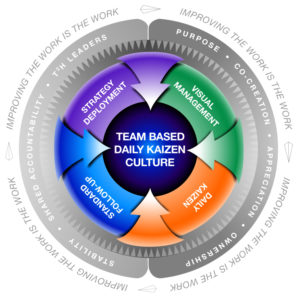
“Full of practical information on what an integrated Lean Management System actually looks like and how to move your organization past theory to practical application. Their approach to coaching leaders has opened my eyes and gave us the ‘real stuff’ we have been lacking.”
Based on the collective experience and work of Mike Martyn and Bryan Crowell, “Own The Gap” exposes many of the conventional myths of leading a lean transformation and explores the intersection between strategy, improvements, and results. Written and researched over a two year period, the book takes the reader through an exploration of a proprietary model that teaches you how to create a culture of daily kaizen where “improving the work is the work”
The book starts the reader on a journey in Chapter 1, with an overview of the elements of our closed-loop management system. The chapter starts with an overview of the management system followed by a “deep dive” into its essential elements, and closes with a discussion of common characteristics, or principles, which must are found in each of the elements of the model. In Chapter 2, time is spent setting the stage by discussing the foundational elements necessary to design effective work systems. These foundational elements paradoxically both precede and arise from the integrated management system – readers need to be aware of them, applaud early victories, and look to strengthen their base as the process of implementation unfolds. Next, Chapters 3-6 form the heart of the book and explore each of the four key systems which together facilitate the creation of a culture of daily kaizen.

Chapter 3 covers the importance of an inspired and aligned organization, and the role strategy deployment plays in enabling everyone in the organization to know what winning or losing means and how their ability to win on a daily basis impacts the goals of the organization. Chapter 4 is devoted to the importance of establishing a robust visual management system. In this chapter we review both the key elements in designing visual systems as well as the integral role visuals play in partnering with strategy deployment to expose actionable gaps. Chapter 5 explores the system of daily kaizen. After the organization has created a system to define and communicate what winning and losing means and visuals have been installed to allow teams to see whether they are winning or losing in real time, the system of daily kaizen allows everyone to give voice to their knowledge of process and to their creativity in a simple and consistent problem-solving process. The key systems exploration finishes in Chapter 6 where the book discusses the elements of standard follow up and the importance of engaging each level of leadership as stewards of each of the key systems, assisting in the daily kaizen process, and increasing organization capability through one-on-one coaching and team member development.
Finally, Chapter 7 gives the reader a sneak peek at the key engagement multipliers that can kick your culture and results to the next level. Understanding how to create an environment that fosters high levels of intrinsic motivation across all team members is critical to building a sustainable culture where stellar results are the rule, not the exception.
It is a common sense approach: create an inspiring vision of the organization you want to become and the culture you need to create. Translate this vision into clear expectations for results and behaviors so every single employee understands what it means to win or lose and how they can potentially and positively affect the bottom line. Build a daily management system that allows you to see how you are progressing toward your goals in real time and enables each team member to leverage their energy and creativity to drive the organization toward its goals. Finally, engage leaders in the role of coaches, where the need to remove roadblocks and develop people is determined by the gaps exposed in our performance.
